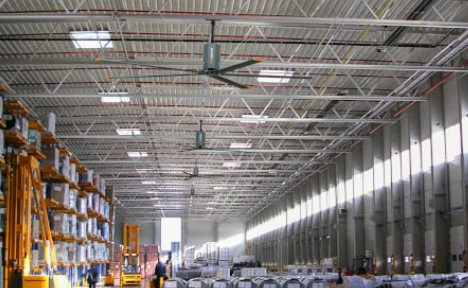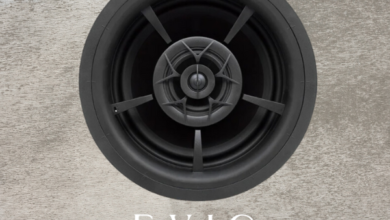Innovative Technologies in Modern HVLS Fans for Warehouses

High Volume Low Speed (HVLS) fans have become essential in enhancing the environment of large industrial spaces like warehouses. These fans are designed to move a significant volume of air at low rotational speeds, providing efficient air circulation and temperature regulation. Modern HVLS fans incorporate various innovative technologies that make them more efficient, reliable, and user-friendly. This article explores the cutting-edge technologies that are transforming HVLS fans into vital tools for warehouse operations.
1. Advanced Motor Technologies
Direct Drive Motors:
Direct drive motors eliminate the need for gears, which are common in traditional HVLS fans. This innovation results in quieter operation, reduced maintenance, and higher efficiency. Direct drive motors enhance reliability and ensure a longer lifespan for the fan.
Permanent Magnet Synchronous Motors (PMSM):
PMSM technology provides superior efficiency and performance compared to traditional induction motors. These motors deliver high power density, allowing the fans to operate more efficiently and with less energy consumption. This advancement helps in reducing operational costs and improving energy efficiency.
2. Smart Control Systems
IoT Integration:
Integrating HVLS fans with the Internet of Things (IoT) enables seamless connectivity with building management systems (BMS). This technology allows for remote monitoring and control, optimizing fan operation based on real-time data such as temperature, humidity, and occupancy. IoT-enabled HVLS fans can automatically adjust their speed and direction to maintain optimal environmental conditions, enhancing comfort and energy savings.
Read more The Ultimate Guide to Showbizztoday.com: Your Gateway to Entertainment News
Variable Frequency Drives (VFDs):
VFDs provide precise control over fan speed, enabling adjustments based on specific needs. This technology allows for better management of energy use, reducing consumption during periods of low demand and enhancing overall efficiency. VFDs help in fine-tuning the fan’s operation to match the exact requirements of the warehouse environment.
Smart Sensors:
Modern HVLS fans are equipped with sensors that monitor various environmental parameters such as temperature, humidity, and air quality. These sensors allow the fans to automatically adjust their operation to maintain ideal conditions, ensuring consistent airflow and comfort while optimizing energy use.
3. Aerodynamic Blade Design
Advanced Airfoil Shapes:
The blades of modern HVLS fans are designed using advanced aerodynamic principles, often inspired by nature. These airfoil shapes maximize airflow while minimizing noise and energy consumption. Improved blade designs enhance the fan’s efficiency and effectiveness in moving air throughout large spaces.
Lightweight Materials:
The use of lightweight yet durable materials such as aluminum or composites reduces the overall weight of the fan. This not only facilitates easier installation but also decreases the load on the motor, improving efficiency and longevity. Lightweight blades also contribute to quieter operation.
4. Energy Efficiency Innovations
Regenerative Braking:
Regenerative braking technology captures and reuses the energy generated when the fan slows down. This innovation significantly reduces energy consumption, making HVLS fans more sustainable and cost-effective. By harnessing this otherwise wasted energy, warehouses can lower their overall energy usage. For additional insights into optimizing warehouse environments, you can also explore the benefits of warehouse fans tailored specifically for warehouse applications.
High-Efficiency Motors:
Motors with high-efficiency ratings, such as those meeting IE4 or higher standards, consume less power while delivering superior performance. These motors are integral to reducing the carbon footprint of warehouse operations and achieving greater energy efficiency.
5. Integration with Renewable Energy Sources
Solar-Powered HVLS Fans:
Some HVLS fans are designed to be powered by solar panels, offering a sustainable energy solution. Solar-powered fans reduce reliance on grid electricity, lowering operational costs and environmental impact. This is particularly beneficial in regions with high solar potential.
Hybrid Power Systems:
HVLS fans can be integrated with hybrid power systems that combine solar energy with traditional electricity. This ensures that the fans operate efficiently even when solar power is not available, providing a reliable solution for continuous operation and further enhancing energy savings.
6. Enhanced Safety Features
Advanced Safety Mechanisms:
Modern HVLS fans are equipped with various safety features such as automatic shutdown during seismic activity or high wind conditions, fail-safe braking systems, and robust mounting hardware. These safety mechanisms ensure the protection of the workforce and the integrity of the warehouse structure.
Fire Safety Integration:
HVLS fans can be integrated with fire suppression systems to automatically shut down in the event of a fire. This helps prevent the spread of smoke and flames, maintaining safety standards in industrial environments and protecting both personnel and inventory.
7. Aesthetic and Functional Customization
Customizable Designs:
HVLS fans now offer a range of customization options, including color, blade design, and finish. This allows warehouses to match the fans with their interior design, enhancing aesthetic appeal without compromising functionality. Customizable designs ensure that the fans blend seamlessly into the warehouse environment.
Multi-Functionality:
Some HVLS fans come with integrated lighting solutions, combining air circulation and illumination in a single unit. This multi-functional approach saves space and reduces the need for additional fixtures, streamlining warehouse operations and improving overall efficiency.
Conclusion
The innovative technologies incorporated in modern HVLS fans have significantly enhanced their performance, efficiency, and versatility. From advanced motor technologies and smart control systems to aerodynamic blade designs and integration with renewable energy sources, these advancements ensure that HVLS fans not only meet but exceed the requirements of contemporary warehouse environments. By adopting these cutting-edge technologies, warehouses can achieve better air circulation, enhanced energy efficiency, and improved comfort for their workforce, making HVLS fans an indispensable part of modern industrial operations.







